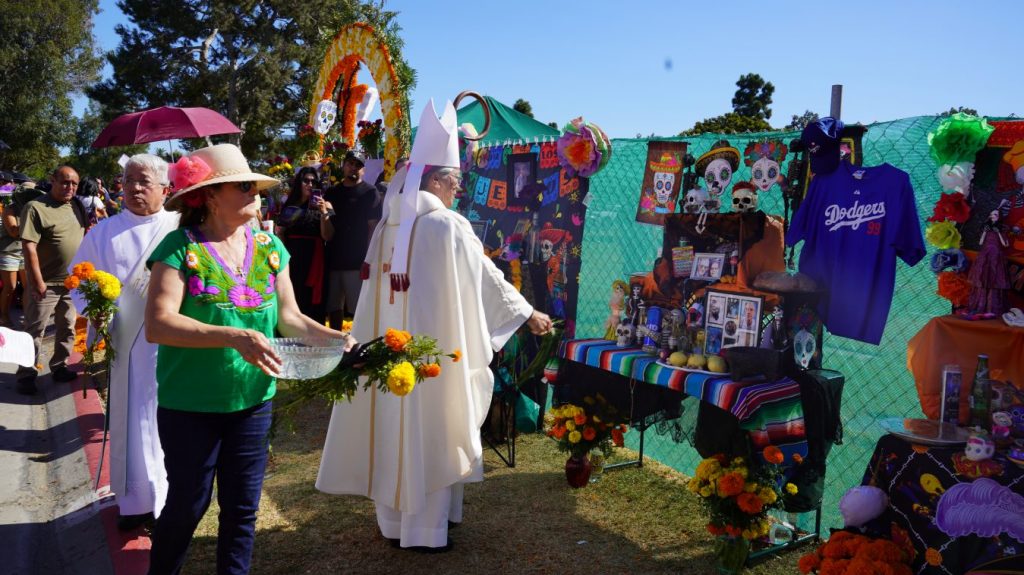Día de los Muertos, or “Day of the Dead,” is a primarily Mexican way of celebrating the feasts of All Souls Day and All Saints Day.
The celebration is an expression of Latin American culture and Catholic beliefs, which makes use of some familiar symbols to teach and celebrate the Church’s teaching on the communion of the saints and the souls in purgatory.
Annual celebrations typically involve skeletal costumes and face makeup, parades and processions, as well as traditional foods such as “pan de muerte” (bread of the dead) and sugar skulls (calaveras).
Los Angeles Auxiliary Bishop Alex Aclan, a native of the Philippines, celebrated a Mass in honor of Día de los Muertos Oct. 26 at Santa Clara Cemetery in Oxnard, California.
The Mass featured pilgrim images of Our Lady of Guadalupe and San Juan Diego, as well as over “ofrendas,” or altars, which are traditionally used in Día de los Muertos celebrations to honor deceased loved ones.
Aclan told CNA the celebrations at the cemetery were very typical Mexican style, he said, with the
There were more than 100 ofrendas set up throughout the cemetery, and participants took part in dancing, processions and prayers for the dead.
Día de los Muertos is sometimes popularly thought of as “Mexican Halloween,” and the ofrendas may be seen as a means for people to conjure up their deceased loved ones.
"That's a corruption of the original notion of the celebration of the feast," Aclan said.
According to the Catechism of the Catholic Church, “all forms of divination are to be rejected” which includes the “conjuring up the dead.”
However, the Church encourages Catholics to pray for the dead as one of the spiritual works of mercy.
Aclan he said he made sure that archdiocesan offices are involved in planning celebrations, to make sure that Día de los Muertos customs are in accord with Catholicism and the Catholic tradition.
The bishop was quick to point out that the real focus of Día de los Muertos are the two Catholic feast days within it, not primarily Halloween.
In his native Philippines, Aclan said, celebrations around this time primarily take place on Nov. 1, All Saints Day, which is marked as a national holiday in that country.
"I grew up with that tradition of All Saints Day, and I remember us staying in the cemetery praying all day long for the souls, even though we do it on the day of All Saints rather than All Souls," he said.
In Mexico, the bulk of the celebrations take place from Oct. 31 to All Soul's Day, Nov. 2, incorporating both of the Catholic feasts.
"All Saints Day of course for those who are already in Heaven, and All Souls Day for those who are still on their way to heaven," he said.
Aclan said whenever he preaches or speaks about Día de los Muertos, he tells people it is a beautiful manifestation of the Church's belief in the communion of saints.
"I think it's a wonderful way to teach people about our beliefs as Catholics on the communion of saints," Aclan commented.
"For Mexicans to celebrate Día de los Muertos, my experience is the remembering of the dead is really the most important part of it. Making sure that the dead are remembered, that their deceased are remembered, and that we really are one with them even though they're on the other side and we're still here."
"And that's basically our teaching on the communion of saints. The different parts of the Church: the ones in Heaven, the ones that are still on their way trying to find their way to the gates of Heaven, and us here on Earth, and we are still together as one. We are still one Church."

